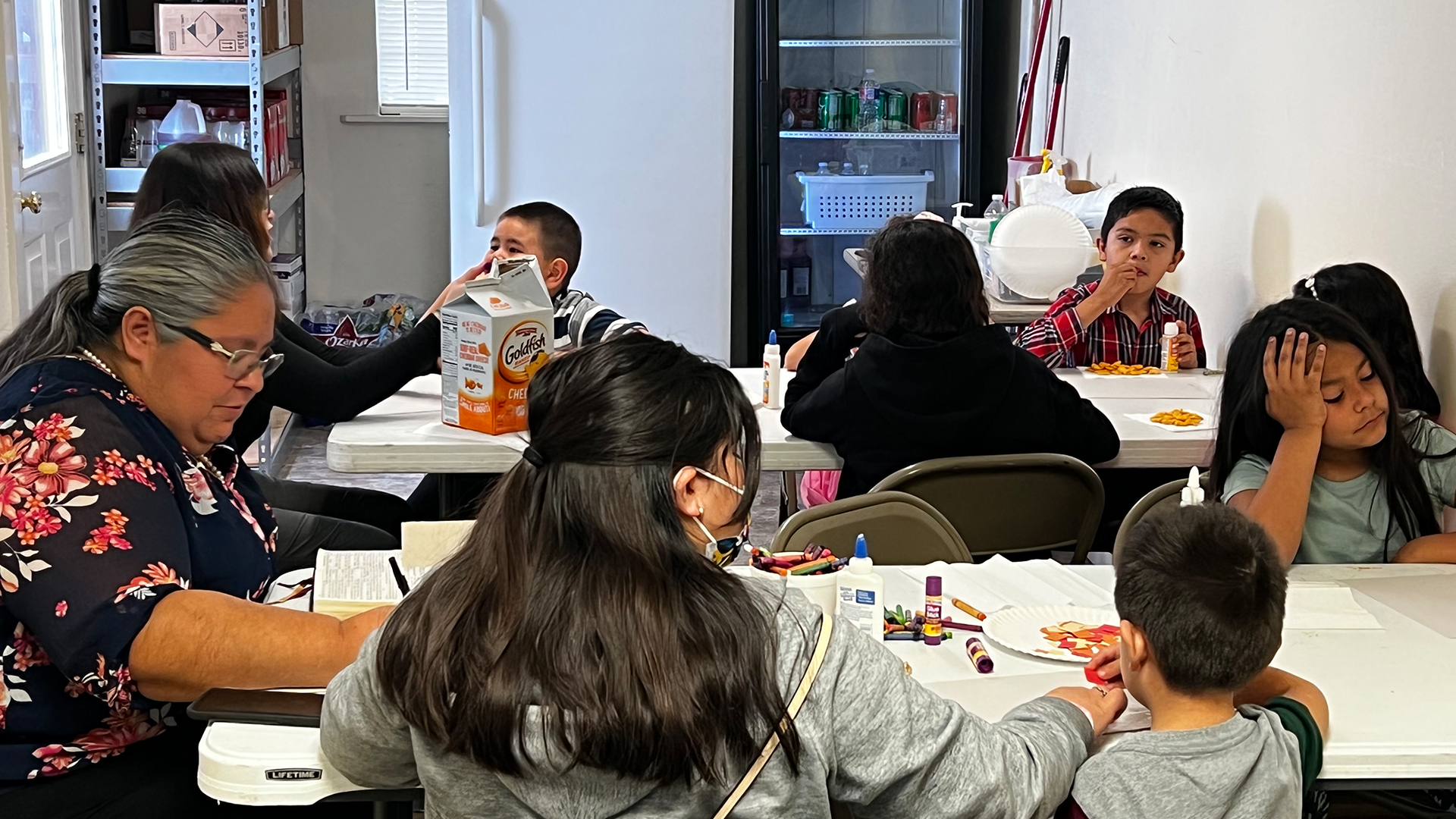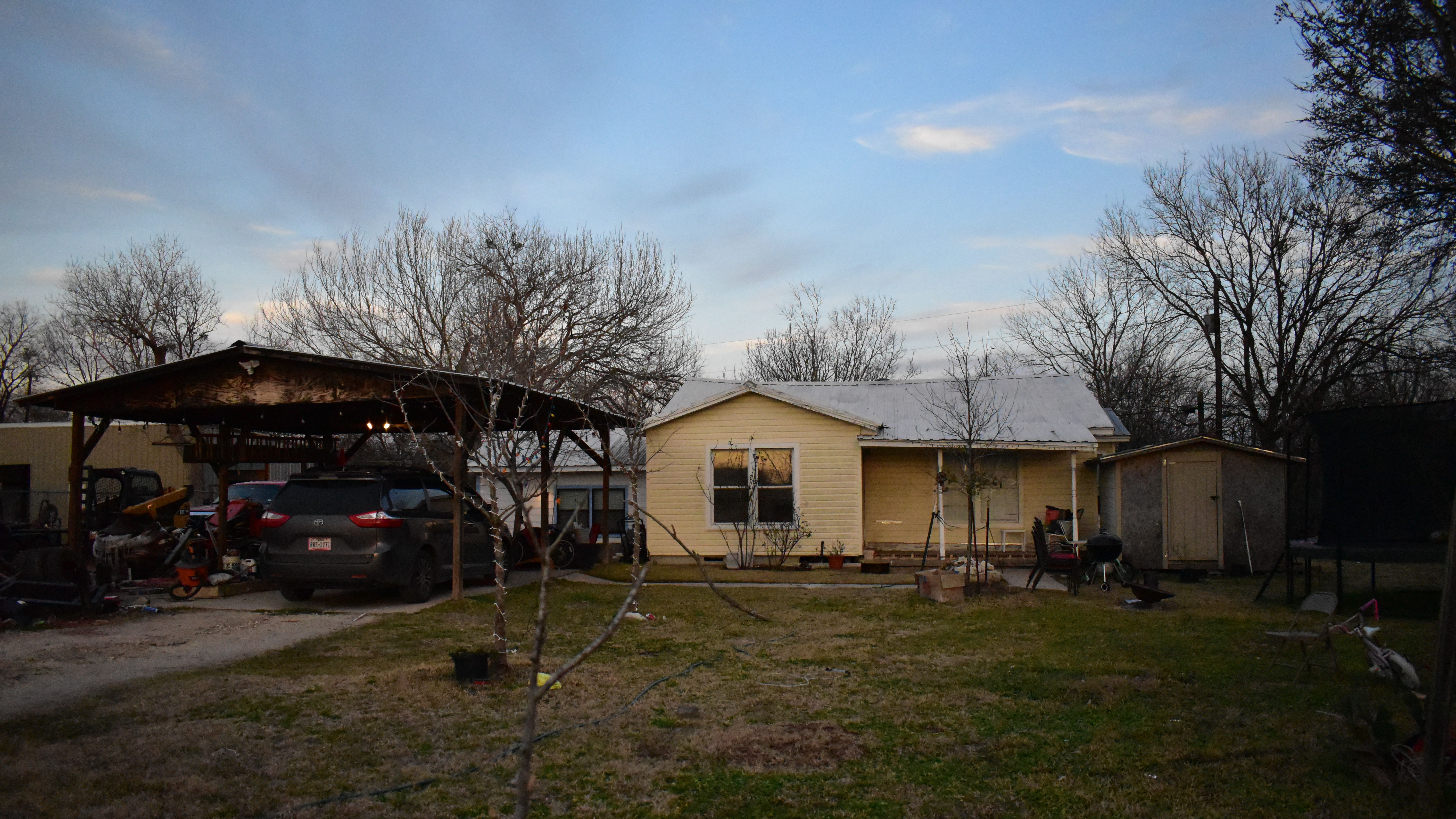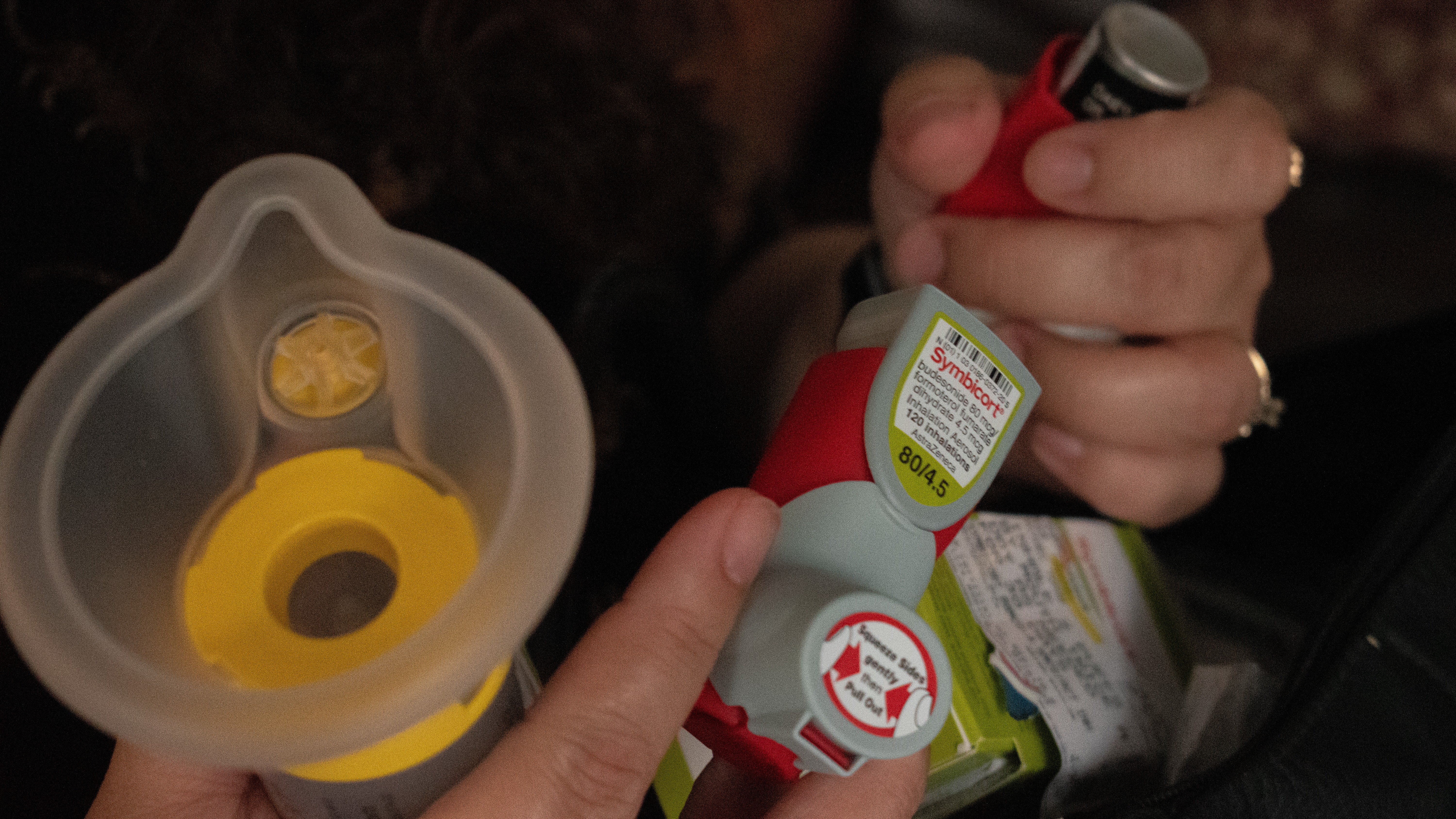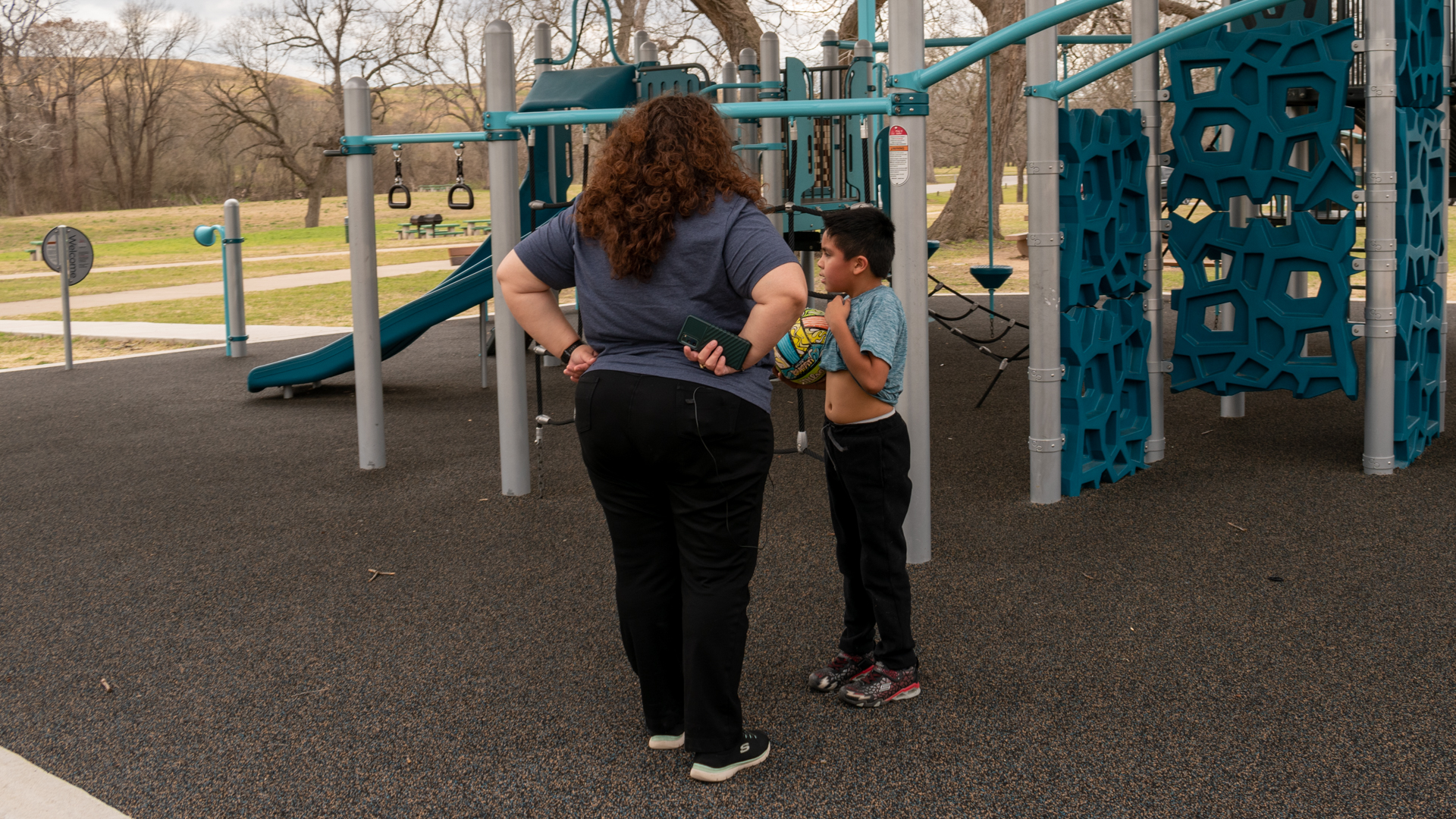The Looming Cloud
It’s Sunday morning, May 16, 2021 at The Church of God of the First Born. Ruth Tovar, superintendent of the church, announces Pastor Gilbert Vera for his sermon. Tovar sits down at the pew next to her son and notices his chest sinking in. He’s struggling to breathe.
“And I'm like, ‘David, are you OK?,’” Tovar says. “He was wearing his mask. I pull it down. I'm looking at him and then his eyes roll in the back of his head.”
Tovar rushed David to the closest emergency room and he was diagnosed with asthma. She and her family are Mexican American, a group that is showing an increase of asthma cases nationally. On a local level, according to a recent report, Black and Latinx kids living in Travis County have higher rates of emergency room visits and hospitalizations for asthma attacks.
David Tovar (right back) eats Goldfish crackers while attending Sunday school at The Church of God of the First Born in East Austin. Ruth Tovar first noticed her son was having trouble breathing and rushed him to the emergency room after Sunday School on May 16, 2021.
“The disparities issue is complicated and multilayered because you have an intersection of environmental racism with discrimination that's related to accessing the health care system and the quality of care that's received,” Dr. Elizabeth Matsui, co-author of the report and associate chair for research for the Department of Population Health at Dell Medical School at The University of Texas at Austin, says.
One of the factors contributing to the disparity is location. The majority of the hospitalizations are occuring in eastern Travis County, an area with large populations of Black and Latinx people. Tovar and her family live in Del Valle, where an estimated 65% of people identify as Hispanic or Latino. While experts like Matsui don’t have a definitive answer to why there are excess asthma emergency room visits in these areas, one of the factors she says she is studying is pollution.
“We know that a variety of environmental exposures are causes, including air pollutants that are outdoors as well as … things like allergens that are indoors,” Matsui says. “And we know from other studies that proximity to traffic and other exposures is known to increase the risk of hospitalization for asthma.”
Tovar lives near the intersection of U.S. Highway 183 and FM 812, where several industrial businesses are located. It's typical to see heavy traffic there with large trucks zipping by, and the Texas Landfill Management’s southeast Travis County facility is less than a mile away.
“You know, all that pollution,” Tovar says. “It's like the wild wild west out here, but it's the east. It's the wild wild east.”
Ruth Tovar’s home in Del Valle is located near a major highway intersection, the Austin-Bergstrom International Airport, the Texas Landfill Management’s southeast Travis County facility and other industrial businesses. According to Dr. Elizabeth Matsui, studies in other areas show exposure to pollution is known to increase the risk of hospitalization for asthma. Photo by Pete Ramirez.
Luckily, when David had his first asthma attack, Dell Children's Medical Center of Central Texas was within minutes from the church the family attends in East Austin. Del Valle on the other hand has no emergency hospitals and counts on just two clinics to service an area with more than 80,000 people.
“Having a hospital so far away in case he needs it, because I know Dell Children's is there. I know that's the best place for any of my children to go if they need help. So it's not that close,” Tovar says.
Del Valle residents also have trouble accessing reliable health information. Barbara Espinosa is a medical assistant at The University of Texas at Austin School of Nursing’s Children’s Wellness Center and works with asthma patients in Del Valle. She says many parents often can’t identify the warning signs of an asthma attack.
“Lot of the times when the asthma patients come in, they're already struggling,” Espinosa says. “They waited so long that they can't breathe anymore. Once in a while, we have to call the EMS.”
Ruth Tovar holds inhalers and medications including Symbicort and Albuterol. Tovar has to keep medications near her son, David, in case he has an asthma attack. Photo by Pete Ramirez.
Tovar found herself in this exact situation. In March of 2020, David became ill. Although he had all of the symptoms, because of lack of testing capabilities at the time, he was not tested for Covid-19. After that, David developed a cough and wheeze. It did not occur to Tovar, these were symptoms of asthma.
“I feel like I'm kicking myself now because I'm like, ‘Why didn't I educate myself?,’” Tovar says. “There's definitely a learning curve.”
While Tovar speaks both English and Spanish, and can communicate with physicians, many other Del Valle residents only speak Spanish, making it more difficult for them to get health care services.
“As far as when they go to specialist offices or somewhere else we might send them, I don't know how much staff is educated in Spanish for those facilities,” Espinosa says.
In 2019, an estimated 3.8% of doctors identified as Hispanic, Latino or of Spanish origin in the U.S. Matsui says in her experience not only is language an issue but so are cultural barriers that can make patients feel less comfortable with physicians.
“Oftentimes there are a lot of concerns about medication or that they have gotten advice from family members or other members in the community to try something different that I may not hear about or may not be expressed to me,” Matsui says.
After speaking to a physician, Tovar learned about triggers and warning signs of asthma attacks. David uses medications including Symbicort and an Albuterol inhaler when doing physical activity. His older siblings are also learning how to recognize symptoms.
“We talk about it, and we talk to David, too ... and so when he can learn to tell us when he needs help,” Tovar says.
Ruth Tovar (right) stops her son, David (left), from playing so he can lift his shirt. She scans his chest to look for signs of a retracting ribcage, a common sign of an asthma attack. Tovar and her family have learned to look for signs of asthma attacks since David’s diagnosis. Photo by Pete Ramirez.
Having more knowledge and resources about asthma has helped Tovar and her family manage David’s condition. Although she still doesn’t know exactly what triggers her son’s asthma attacks, she says she would like to see changes occur in her neighborhood.
“Austin and Del Valle, they've kind of ignored the residents out here,” Tovar says. “So I'd like them to step in and start regulating … especially these companies up here that are doing a lot of the industrial work.”
Still, what will continue to worry her is the unpredictability of asthma, and not knowing when David could have another attack.
“It's like a roller coaster. We're doing fine. We're up here,” she says. “All of a sudden we're crashing and burning.”
Community journalism doesn’t happen without community support.
Got story ideas, advice on how we can improve our reporting or just want to know more about what we do? Reach out to us at news@klru.org.
And if you value this type of reporting, then please consider making a donation to Austin PBS. Your gift makes the quality journalism done by the Decibel team possible. Thank you for your contribution.
More in Health:
See all Health posts









Contact Us
Email us at news@klru.org